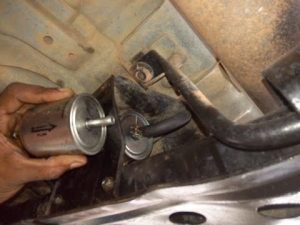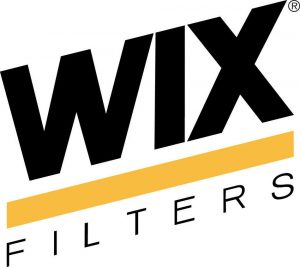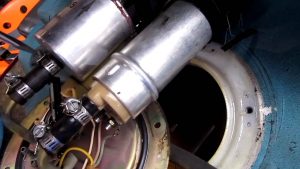Most people – not just car people – know about air and oil filters – and that both need to be changed every so often.
But how many people even think about fuel filters anymore?
New cars do have them – it’s one of the few things that today’s cars and yesterday’s cars still have in common. The difference is where they’re located.
In yesterday’s cars, people thought more about fuel filters because they saw them more often. Every time you raised the hood of a car with a carburetor, you’d see the fuel filter – which was almost always located near the carburetor – which sat right on top of the engine. Whenever the carburetor was adjusted – a routine thing, back when cars had carbs – it was reflexive to have a look at the filter. It was replaced routinely as part of fuel system service – to keep contaminants such as grit, rust flakes and so on from being sucked into the carburetor and then into the engine.
It’s just as important to replace fuel filters today – for the same reasons – but it’s easier to forget to do it because regular tune-ups are a thing of the past with fuel-injected cars, which can go for years without anyone adjusting anything. And also because the fuel filter is no longer (usually) under the hood.
Instead, it’s generally in one of two other locations – one good (in terms of DIY) maintenance.
The other not-so-good.
The good location is somewhere under the car – as in the case of my ’02 Nissan Frontier, the guinea pig for this article.
Because you can get at the filter.
If it’s a truck, like mine, you may not even need to jack up the vehicle to reach the filter. You can just shimmy underneath with a flat blade or Phillips head screwdriver – to loosen the worm gear clamps that hold the rubber hose sections to the inlet and outlet nipples of the old filter and (gently) slide the hoses off the old filter.
It’s a good idea to use a hemostat or vise grip pliers – adjusted to not squeeze too tight – to clap down on the hoses just aft of the inlet/outlet nipples before removing the old filter; this will prevent gas from leaking out of the hoses while you are in the process of installing the new filter.
Whatever you do, don’t leave the ignition switch in the “run” position while you do this job. If you do – and if you haven’t clamped the lines – you’ll get soaked with gas, which will be pumped out of the open lines by the electric fuel pump that all fuel-injected cars have. Back in the carb days, cars had mechanical fuel pumps – and they only pumped when the engine was running.
What’s the same as before is to make sure you install the new filter in the right direction; there’s usually an arrow stamped on the body that will tell you which way. Be sure you don’t install it the wrong way.
Now is also a great time to check the condition of the rubber hoses that usually connect to each end of the filter – and to the hard steel fuel lines.
If they’re brittle or you see cracks, replace them. Even if you don’t, if the rubber’s more than eight years old, it’s good preventive maintenance to replace them now – before they leak. Be sure to get hose that’s made for fuel-injected vehicles as the line pressure is much higher than it was back in the carb days.
And use a good-quality filter. This is at least as important s replacing the filter – because a crappy replacement filter can be just as bad (and maybe worse) as not replacing the filter at all. I personally like and use Wix filters (gas and oil) and recommend them, not because Wix is paying me to recommend them but because they’re good filters and worth the couple of extra bucks you’ll pay up front vs. what you might end up having to pay down the road if you go with a poor-quality filter to save a few bucks up front.
But what about the not-so-good place?
It’s in the tank – where it’s not easy to get at. It’s still DIY-doable, but it’s going to take more pertinacity – and elbow grease – to do the job.
You can find out which job you’re facing by reading up on the replacement procedure in a service manual for your particular vehicle – which you can probably find online and so not necessarily have to buy.
Even if you don’t do this job yourself, it’s a good idea to familiarize yourself with how it’s done.
And not forget that it needs to be done.
…
Got a question about cars, Libertarian politics – or anything else? Click on the “ask Eric” link and send ’em in!
If you like what you’ve found here please consider supporting EPautos.
We depend on you to keep the wheels turning!
Our donate button is here.
If you prefer not to use PayPal, our mailing address is:
EPautos
721 Hummingbird Lane SE
Copper Hill, VA 24079
PS: Get an EPautos magnet or sticker or coaster in return for a $20 or more one-time donation or a $10 or more monthly recurring donation. (Please be sure to tell us you want a magnet or sticker or coaster – and also, provide an address, so we know where to mail the thing!)
My latest eBook is also available for your favorite price – free! Click here. If that fails, email me at EPeters952@yahoo.com and I will send you a copy directly!












When the work truck (2011 F150) hit 300,000 I took it to the shop and asked them to go though stem to stern and give it a good looking over (and oil change). I also asked them to replace the fuel filter. They said the fuel filter shouldn’t be replaced unless there’s a problem with it, and a quick check online doesn’t say much of anything about fuel, other than if running E-85 to run a tank of normal gas for a tank following an oil change.
Hi RK,
I’m very wary of these “lifetime” (no service) things… especially filters. They clog, inevitably. Now the pump is working harder to get the fuel to the engine, probably shortening its life, too.
Some of these pumps – these pump assemblies – are haltingly expensive, too. In some cases, close to $1,000 for the “assembly.”
Unless today’s gasoline is free of contaminants – including whatever gets pumped into your tank from the in-ground tank at the gas station – I think changing the filter at least every 50,000 miles is a must-do.
eric, I completely agree. You might assume the fuel system is fine because you have no problems. That doesn’t mean the fuel pump isn’t working itself to death to keep the correct pressure.
It’s been over 50 years since I found out fuel filters can get clogged nearly instantly or it seems like it’s instantly. Regardless of what I am driving, I keep an extra with me. I’m going to change it every year or less anyway so one stashed in a side pocket(inside my crossover box is a hard life for everything) or other stash place. I’m not keen on replacing it on the side of the road but I’d rather have the option than to be dead in the water so to speak.
I used Wix or Purolator, both good brands. I will take anything I can get if I have a problem as I once had on my little Nissan pickup. It just went to crap on the road and had a 150 miles or more to go. I stopped and got one at the next town and learned it wasn’t that easy to change but it had to be done.
I sorta cussed myself since every other vehicle I owned had a new fuel filter stuck somewhere in the cab. That one did after that. But nowdays, the fuel pump, especially one with 300,000 miles needs to be replaced no matter that it’s running ok. I listen for the fuel pump to be working hard when I run a gate and have to get out. And they will make a lot of noise you can hear walking beside the vehicle. Being an old trucker, I’m keen on doing walk-arounds. You can find problem that’s about to be a bad one just walking around one with the engine running. I sometimes do a walk-around when it’s turned off since some sounds, like a leaking tire can’t be heard when the engine is running and if they can, you’d better get it on a spot where you can change a tire because you’re probably going to be doing so in a minute or two. If I hear a leak at the gate on the driveway I try to make it to the barn where the floor jacks and roll-around is located. To paraphrase Bobby Bland or for some, I pity the fool who doesn’t have a floor jack…..so much so I carry a small one in the pickup. It works a lot better than a dammit jack.
I meant “or for some, Mr. T”.
I’m sure. If it were my truck I’d probably have it replaced or figure out how to do it myself. But they pay for it, so it goes where they want for service.
Hi RK,
Yup! Taking care of what’s ours gives us an incentive to take good care of it. Which, of course, is why “publicly owned” stuff is usually decrepit, shoddy and other wonderful things…
With fuel injection, you need to bleed the pressure from the fuel system before opening any part of the system. The procedure differs with each car. You’ve just reminded me that mine is due for a change and I have to look up the procedure for bleeding fuel system.
One of my old-ish cars that I’m keeping forever is a 2003 manual transmission Infiniti G35 Sedan, love that thing. It hit 200,000 miles recently, so I decided to open the tank and fix a fuel level float, and replace filters while I was at it. I was positively shocked to discover that after 17 years and 200k miles, the inside of the tank looked as new as the day the car was built, and the fuel filter was immaculate. Thankfully, getting to the fuel pump in this car is trivially easy – yank up rear seat, undo a few bolts, and voila, you have a hole in which you can soak your hands in gas all day.
Many of the new ones have it installed inside the fuel tank, good luck with that!
Well, mine isn’t as easy as yours, but not as hard as in the gas tank. It’s apparently in the fuel pump, under the rear seat. I’ve asked shops to change it out, but they say, no, it’s a lifelong filter.
I leave it to the dealers. Today’s cars are just too hard and too easy to screw up. (imho)